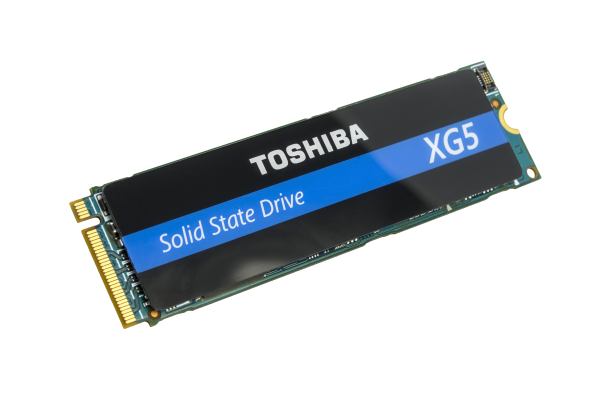Toshiba Readies XG5 NVMe SSD With 64-Layer BiCS
Toshiba displayed the first working 64-layer NAND at Dell World, and now we can name the product, XG5. Now, Toshiba has flipped the notebook over to unveil the new XG5 NVMe SSD and give us some details about the OEM client SSD designed for mainstream to high-performance systems.
The XG5 uses four lanes of PCI Express 3.0 to achieve up to 3,000 MBps sequential read and 2,100 MBps sequential write performance from its 3-bit per cell (TLC) 3D NAND. We expect the new 64-layer BiCS NAND to plow through advanced workloads at high speeds, but Toshiba wouldn't disclose random performance for a typical configuration because each OEM will design limits based on thermal and power consumption needs.
The company did want to talk about power consumption, and the attractive numbers tell us why. The XG5 uses less than 4.6W in an active read state, and that falls to 3W for active writes. Idle consumption comes in at just 3mW. That equals the power transferred during a shock on a doorknob after walking across your grandmother's 1970s shag carpet.
The drive will initially come to market as an OEM client SSD with capacities ranging from 256GB to 1TB. The series will use a mix of 256Gbit and 512Gbit BiCS die, depending on the capacity size. Aftermarket shoppers will receive a modified version under the OCZ RD product line. (The same thing happened with the RD400 that was akin to the Toshiba XG3.) We won't see a retail branded model until late in the year, as Toshiba has to sort through time consuming qualifications from several OEM customers. With the drive on display at Dell World, we can assume XG5 will ship in back-to-school systems from the company later this year.
Both Toshiba and manufacturing partner Western Digital plan to utilize BiCS for a number of devices in 2017. 3D NAND technology will surpass planar NAND in bit output produced and shipped in the second half of 2017. A Toshiba representative told us that "XG5 will deliver similar endurance to the XG3 with 15nm planar MLC technology."
We don't yet know how well BiCS compares to Samsung's and IMFT's 64-layer 3D NAND technology. What we do know is that the increase in bit output will ease the current supply issues and get us back on track for decreasing SSD prices. The NAND race is about to heat up again with the additional 3D technologies that reset the endurance clock and spur lower prices that aid user adaption.
Get Tom's Hardware's best news and in-depth reviews, straight to your inbox.

Chris Ramseyer was a senior contributing editor for Tom's Hardware. He tested and reviewed consumer storage.
-
alextheblue Reply
Yes! We continued making progress in terms of performance, but we stalled in terms of price/capacity. Lower pricing for high-capacity drives can't happen soon enough. My next build is going to have a 1TB NVMe SSD for primary storage. Games are getting big.19753022 said:We don't yet know how well BiCS compares to Samsung's and IMFT's 64-layer 3D NAND technology. What we do know is that the increase in bit output will ease the current supply issues and get us back on track for decreasing SSD prices. The NAND race is about to heat up again with the additional 3D technologies that reset the endurance clock and spur lower prices that aid user adaption.
